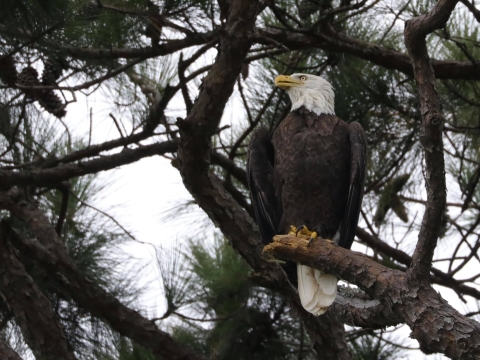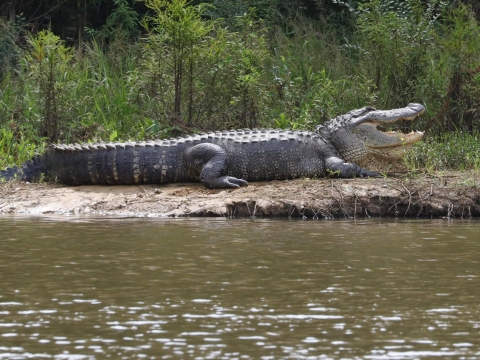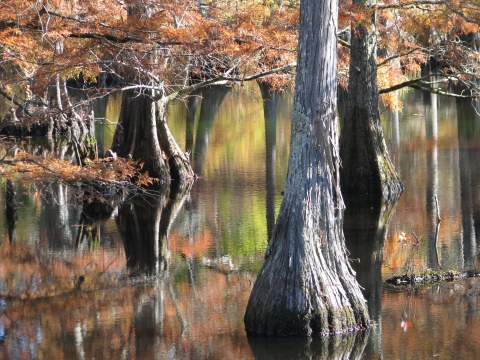Seasons of Wildlife
January: Bald eagles are nesting and present on lakes. Prescribe burns for wildlife habitats.
February: Red maples and elms bloom. Bald eagles hatch and can been seen in nests. Black vultures and red-shouldered hawks are nesting. Prescribe burn for habitats continue.
March: Wild turkeys are gobbling. Eagles migrate off refuge. Bass are spawning. Giant Canada geese and wood ducks are nesting. Redbud, crabapple, wild plum, and dogwood bloom.
April: Geese goslings and wood duck ducklings are visible. Bullfrogs are croaking. Snakes and turtles become active. Doves begin nesting. Shad are running in river. Turkeys are nesting. Red-cockaded woodpeckers are starting to nest.
May: Bluegill and catfish are spawning. Cattle egret and heron rookeries are active. Bluebirds and Prothonotary warblers are nesting. Alligators are active. Chuck-wills widows are calling.
June: Queen Ann's lace and maypops bloom. Turkey and grey squirrel young are visible. White-tailed deer fawns are born. Blackberries are ripe. Bobwhite quail are calling and nesting.
July: Purple martins leave their nests. Black-eyed Susans and purple cone flowers bloom. White-tailed deer with young are visible. Cattle egret rookery full, cormorants and anhingas on Bluff Lake. Selected lakes are de-watered.
August: Teal and shorebirds migrate early. Ironweeds bloom. Wood storks are present and on lakes. Cattle egrets are nesting. Alligators are very visible.
September: Muscadines and fall plums ripen. Shorebirds and broad-winged hawks are migrating. Blue-winged teal pass through.
October: First appearance of osprey and bald eagles are usually reported. Hickory nuts and acorns are falling. Peak of fall bird migration. Squirrels are barking. Wild persimmons are ripening. Fall colors start to show. Waterfowl impoundments begin flooding.
November: End of season for flowering plants. Peak of fall colors. Expect killing frost. Woodcock flights arrive from the north. Wintering bald eagles and osprey appear on lakes. Waterfowl numbers build.
December: Peak hunting month. Deer are in rut. Late acorns fall. Horned owls being nesting. Bald eagles and osprey are present on lakes.
Featured Species
The refuge was established as a migratory bird refuge. As part of that, it is charged to protect endangered and threatened species and to provide feeding, nesting and roosting areas for migratory birds. Today the refuge not only has the endangered red-cockaded woodpecker, but also plays host to over 200 other species of birds.
Though not commonly seen during daylight hours, river otter, raccoon, skunk, beaver, and opossum are also among some of the refuge residents along with bobcats and foxes who are frequently seen crossing the roads or slipping through vegetation early in the mornings.



